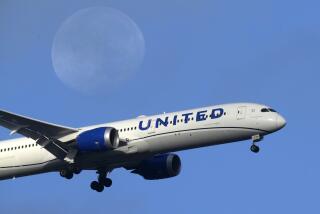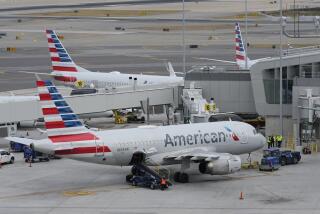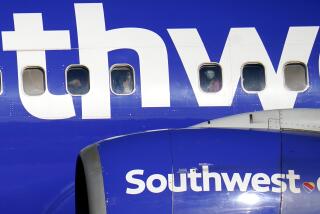Frequent-Flier Miles Complicated, Although Not Impossible, to Spend : Airlines: What looked like an ingenuous marketing plan backfired when frequent-fliers suddenly began cashing in triple mileage awards. To compensate, carriers have changed their rules.
The madness started two years ago when Delta Airlines thought it had discovered a marketing bonanza. The airline sent letters to its frequent-flier program members announcing a special mileage bonus deal: For each member flying Delta and using an American Express credit card, Delta would award triple mileage.
It seemed like a profitable arrangement for both Delta and American Express. The airline would get passengers and American Express would get ticket sales.
But before the Delta deal got off the ground, Eastern Airlines tried a little one-upmanship. Eastern announced that anyone who flew Eastern, regardless of the form of payment, would receive triple mileage.
The war commenced. Within days, every major U.S. airline got caught up in the triple-mileage madness. In short order, travelers didnât have to be frequent fliers to rack up big mileage in record time.
Thatâs the good news. But what can you do with those miles?
The airlines had always defended the mileage programs within their industry as cost-effective, because of low redemption levels. While no specific figures are available, three senior airline officials of competing airlines told me that only 5% to 7% of all miles earned are ever redeemed.
One reason redemption levels had been low was that those who earned high mileage had flown so frequently they were probably the last ones eager to get on a plane again. Another reason may have been that frequent fliers seemed more interested in reaching the next award level than in cashing in their existing miles.
Thanks to triple mileage offers, those award levels were reached much faster than anyone anticipated. Suddenly, record numbers of passengers were cashing in their miles for free or discount trips. What had looked like a profitable marketing idea had turned into a potential disaster.
The airlines already had agreed to a mandate by a number of state attorney generals not to change eligibility or mileage levels without sufficient notice to members, so changing award levels was out of the question.
But airlines, suddenly confronted with the numbers--a significant accumulation of unredeemed miles--have begun to significantly change the bonus game.
Do the words âblackoutsâ and âcapacity controlsâ ring a bell? If youâve tried to redeem any of your awards, then you know these terms well. More than ever, the airlines want to control when you fly and where you fly, even the routing of those flights you can get on using a bonus award ticket.
For example: Youâve earned an award ticket to Hawaii, and you call the participating airline to book your seats, only to discover that âthere are no mileage award seats available on your flight.â
That doesnât necessarily mean the flight is sold out. What it does mean is that the airline has severely limited the number of free seats that can be booked on popular routes. On some Hawaii flights, airlines have allowed only two seats per flight to be awarded to frequent flier redeemers.
Does this mean you are out of luck if you didnât get one of those seats and you want to go to Hawaii? Not necessarily. If a reservations agent tells you that no award seats are available, but that there are seats available on the flight itself, ask to speak to a supervisor.
A frequent-flier program exists, after all, to reward passenger loyalty. A gentle reminder to a supervisor of your loyalty can sometimes result in an agent overriding his or her airlineâs computer and issuing you a ticket.
The latest frequent-flier bonus, called âone free for three,â good through April 6, promises a free ticket if you fly three round trips between now and then.
But read the fine print carefully. United and American, for example, offer the deal if you fly three round trips costing at least $98. But the resulting free ticket is good only in the continental United States and only in the fall, and there are holiday blackouts and other restrictions.
Continental offers the deal after only two round trips. But the qualifying fares must be at least $196 each. To make matters worse, qualifying trips must be taken between a Sunday and a Friday. (What this means is, you canât book an excursion fare on Continental that requires a Saturday night stay, which usually means a lower air fare.) Again, check out when you can use the free ticket youâve earned.
If youâre a member of Northwestâs frequent-flier program, called âWorldperks,â donât be surprised to find an occasional free ticket in the mail. Thatâs Northwestâs way of disposing of accumulated mileage.
The airline now automatically sends its program members tickets when they reach 20,000-mile award levels. But each ticket has an expiration date, as well as a list of blackout dates and other restrictions.
There are some airlines that have somehow managed to stay out of the frequent-flier craziness.
âWeâve watched all this frequent flier stuff with a certain amount of amusement and a great amount of concern,â says Herbert Legner, deputy vice president of Austrian Airlines.
âWe decided that a frequent-flier program is a good idea if youâre the first one and the only one. After that it becomes an expensive headache.â
Still, when Austrian Airlines recently decided to enter the U.S. market (with nonstop flights between New York and Vienna), it reluctantly started a frequent-flier program. But instead of awarding free tickets on Austrian Airlines, the program rewards fliers with cash in the form of âMCOâ tickets. MCO stands for âMiscellaneous Charge Order,â and is a negotiable form of airline currency.
The Austrian program rewards âcashâ based on mileage; MCO tickets are issued when a memberâs account rises above $400. The âcashâ can then be used as credit toward the purchase of tickets on virtually any major airline in the world.
Cathay Pacific has also managed to avoid frequent-flier programs. The Hong Kong-based carrier, while a partner in other U.S. airline programs, offers no real mileage program to its regular passengers.
âWeâre happy about that,â said Peter Sutch, Cathayâs deputy chairman and chief executive officer. âThese programs have reached ludicrous heights in the United States, and sooner or later that unredeemed mileage has to be accounted for on your balance sheet.â
One more thing. While no one was looking, triple mileage snuck back in. Alaska Airlines is offering triple mileage to its program members through April 6.
Pan Am, eager to drum up much-needed business during these slow off-season months, is offering triple miles to its frequent fliers until April 15. Any Pan Am or Pan Am Express flight within the United States (including Hawaii), and to Bermuda, the Caribbean or Mexico (even within the Caribbean) qualifies for triple mileage.
On flights between the United States and Europe, India, Pakistan or Africa, between Europe and India, Pakistan or Africa or on Pan Am flights within Europe, the airline awards double the actual miles flown.
More to Read
Sign up for The Wild
Weâll help you find the best places to hike, bike and run, as well as the perfect silent spots for meditation and yoga.
You may occasionally receive promotional content from the Los Angeles Times.






